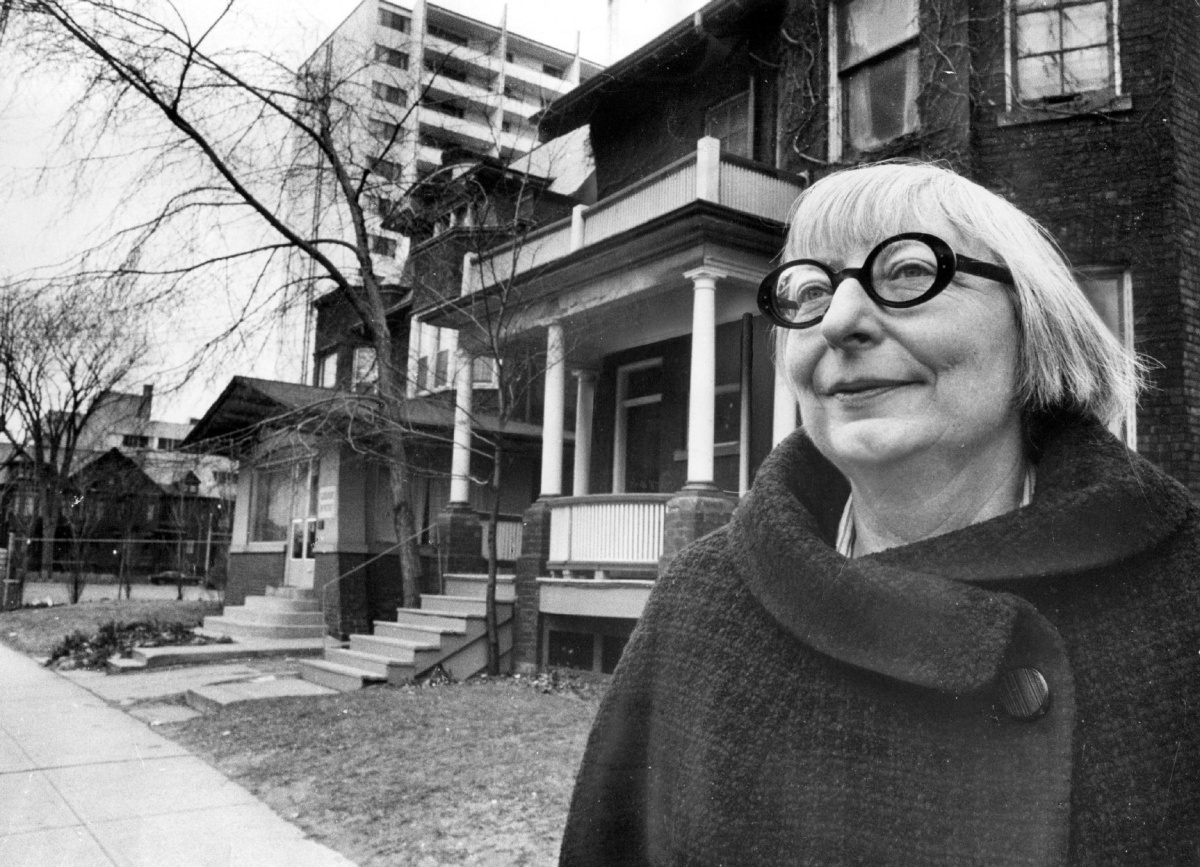
Jane Jacobs (1916-2006) would have been 100 today. The candy factory secretary and mother, turned journalist and activist didn't have a college degree or any formal training in urban planning--although she continues to be a major influence on the urban planning field. Her 1961 book, The Death and Life of Great American Cities, was an attack on modernist planning principles in favor of an appreciation for organic urban vibrancy.
Photo: Philosophers' Mail

Robert Moses was a leading planner in New York City. His plans for "urban renewal" included leveling much of Greenwich Village to make way for high rises and a ten lane highway that would have run right through Washington Square Park. Jacobs lived in Greenwich village and her children played in Washington Square park. She led a grassroots effort to stop the plan from moving forward.


The 1950s plan Jacobs was fighting against.
Source: Ephemeral New York

"There is nobody against this - NOBODY, NOBODY, NOBODY but a bunch of, a bunch of MOTHERS." This is what Robert Moses said in 1958, as he left the hearing where it was decided that the Lower Manhattan Expressway Project would not be built and Washington Square Park was saved.
Photo: Aesthetic Realism

A few years after Jacobs defeated Moses, city leaders in Fresno, CA embarked on a plan to revitalize its city center with people, not cars. The plan was created by Victor Gruen, who had a complicated past as a modernist planner himself. More about that here.

In 1964, the Fulton Pedestrian Mall was born.

In a report on the State of Historic Preservation presented at a 2010 Fresno City Council meeting, Jacobs was quoted related to the Fulton Mall.
Source: City of Fresno
![]()
![]()
![]()

It took them a little over 50 years, but they just killed it. One has to wonder what Jane would have done?
Photo: They Killed the Fulton Mall

It could be said that the creation of the Fulton Mall was in fact a modernist scheme, but in a 1958 article in Fortune Magazine, Jacobs commented on a proposed Gruen plan for Fort Worth, Texas:
Photo: Philosophers' MailThe plan by Victor Gruen Associates for Fort Worth is an outstanding example. It has been publicized chiefly for its arrangements to provide enormous perimeter parking garages and convert the downtown into a pedestrian island, but its main purpose is to enliven the streets with variety and detail. This is a point being overlooked by most of the eighty-odd cities that, at last count, were seriously considering emulation of the Gruen plan's traffic principles.There is no magic in simply removing cars from downtown, and certainly none in stressing peace, quiet, and dead space. The removal of the cars is important only because of the great opportunities it opens to make the streets work harder and to keep downtown activities compact and concentrated. To these ends, the excellent Gruen plan includes, in its street treatment, sidewalk arcades, poster columns, flags, vending kiosks, display stands, outdoor cafes, bandstands, flower beds, and special lighting effects. Street concerts; dances, and exhibits are to be fostered. The whole point is to make the streets more surprising, more compact, more variegated, and busier than before - not less so.One of the beauties of the Fort Worth plan is that it works with existing buildings, and this is a positive virtue not jusf a cost-saving expedient. Think of any city street that people enjoy and you will see that characteristically it has old buildings mixed with the new. This mixture is one of downtown's greatest advantages, for downtown streets need high-yield, middling-yield, low-yield, and no-yield enterprises. The intimate restaurant or good steak house, the art store, the university club, the fine tailor, even the bookstores and antique stores - it is these kinds of enterprises for which old buildings are so congenial. Downtown streets should play up their mixture of buildings with all its unspoken -- but well understood -- implications of choice.

Jane Jacobs was not a fan of post-war modernism. She criticized the father of modern planning, Le Corbusier's “Towers in the Park" concept of separating uses and building high-rise buildings surrounded by green space. Although, he was a great architect, it's safe to say that Le Corbusier's modernist planning dogma failed. Jacobs explained, "To approach a city, or even a city neighborhood, as if it were a larger architectural problem, capable of being given order by converting it into a disciplined work of art, is to make the mistake of attempting to substitute art for life. The results of such profound confusion between art and life are neither life nor art. They are taxidermy." This seems like a good place to point out the obviously modernist owl on Jane's mantel. Learn more on Curbed.Photo: Ron Bull, via Vox